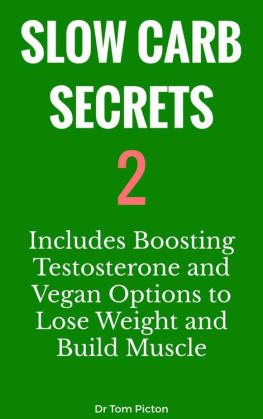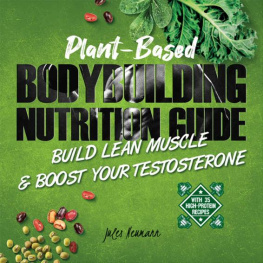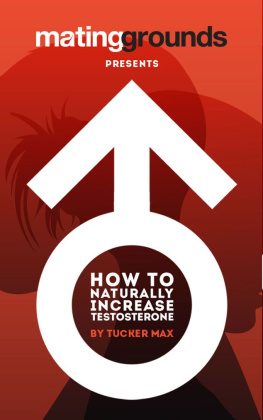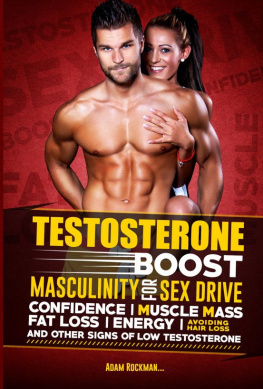Copyright
Testosterone Trifecta: Triple your T Production naturally for increased muscle mass, fat burning, less stress and great sex
SJ
www.IgnoreLimits.com
Copyright 2014
All rights reserved
This book or any portion thereof may not be reproduced or used in any manner whatsoever without the expressed written permission of the publisher except for the use of brief quotation in a book review
Contents
Introduction
I want to thank you and congratulate you for downloading the book, Testosterone Trifecta: Triple your T Production naturally for increased muscle mass, fat burning, less stress and great sex .
This book contains helpful information about what testosterone is and its effects on the body. It is actually one of the most important hormones in a mans body that affect not only the reproductive system, but the body as a whole.
This book will explain to you tips and techniques that will help you to improve the levels of testosterone in the body in order to achieve better health and a lean, muscular looking physique.
Thanks again for downloading this book, I hope you enjoy it!
My Definitive Guide To Fat Loss Is Now Available!

I Shredded Unwanted Fat Without Any Bullsh*t Supplements Or Mind Numbing Cardio...Now Let Me Show You How
Including..
- The Truth About Fat Loss That You Haven't Been Told
- The 2 Essential Keys To Success On Your Fat Loss Journey
- 23 Fat Loss Myths Fried - Debunking The Lies, Broscience & Wives Tales
- Understanding Energy In Vs. Energy Out
- How To Reduce Stress To Lose More Fat
- How To Lose Fat Without Counting Every Calorie You Eat (YES, It's Possible!)
- Divulging The Popular Diets - Including Intermittent Fasting, Paleo, Ketogenic & More!
- A Look Into Supplements And The Only 2 Supplements That WILL Help You Burn More Fat
- My Methods To Reduce Bloating & Water Weight To Reveal That Lean, Dry Physique
- Workout Regimes (That Are Actually Enjoyable!) Designed To Obliterate Fat
- How To Track Your Progress Correctly
- My Personal Tricks & Techniques To Remain Sane & Keep The Fat Loss Furnace Burning
- Useful Links, Referenced Studies, A Glossary Defining The Must Know Terms (No Broscience)
Grab your copy of .F.U. Fat now while its on special, I GUARANTEE you its the only book youll ever need to get shredded!
>> Check it out here <<
With a 100% money back guarantee theres literally no risk.
Bonus Content
As a token of my appreciation Id like to give you access to my exclusive bonus content.
Heres what youre about to receive...

- The Bodyweight Barrage eBook - the ultimate guide to building muscle & shredding fat without a gym, including exercise descriptions, photos & more!
- Immediate email access to me, SJ. Ask me anything, and I'll give you an answer
- My honest product reviews & recommendations
In order to claim your bonus content simply navigate to my site: www.IgnoreLimits.com
Enter your email in the box so you can receive this exclusive content instantly!
As this is a limited time offer I recommend claiming your Bodyweight Barrage ebook before proceeding to read the book.
Chapter 1 Understanding Testosterone
Androgens refer to a group of male hormones that play many crucial roles in the body. One important hormone that belongs to this group is testosterone. This male hormone is produced in the testes and regulated by the hypothalamus in the brain.
Types
Three subtypes of testosterone are produced in the body, classified by what proteins are and are not attached to the basic steroid structure.
Free testosterone
This is the purest form of testosterone. There are no proteins attached to the basic structure, hence, considered unbound or free. They easily enter the cells and activate cellular receptors to stimulate various cellular processes that produce the benefits of testosterone. Free testosterone is the one that produces the most beneficial effects, but is also the smallest in amounts. It only accounts 2 to 3% of a mans total testosterone levels. This is also the type of testosterone that should be increased.
SHBG-bound Testosterone
This type comprises about 40 to 50% of a mans total testosterone levels. The testosterone molecule binds with the sex-hormone-binding-globulin or SHBG, which is produced in the liver. This type regulates the free testosterone levels in the body. In itself, SHBG-bound T is biologically inactive, which means the body cannot use this T type. It can help neither build muscles nor boost the mood. In normal levels, SHBG-bound T is not bad, but too much of it is not desirable. Tests would reveal high testosterone levels but still suffer from deficiency symptoms. SHBG tends to bind itself to a lot of testosterone, leaving too few free T for the body to use.
Albumin-bound T
Some testosterone binds with albumin, a protein produced in the liver that mainly functions for the stabilization of extra-cellular fluid volumes. This bound testosterone is also biologically inactive, which means the body cannot also use this form. The difference with SHBG-bound T is that the bond between albumin and testosterone is weak and can easily be destroyed in order to release the T and be available for the body to use.
How testosterone is made
Testosterone is produced in the testes and the adrenals. 95% of the total T is produced in the testes and the remaining small percentage in the adrenals. T production happens even during childhood (in minimal amounts) and the process is jumpstarted during puberty, to about 18 times more. T production starts when the brain sends out a signal to the adrenals and testes to start the process. When low T level is detected by the brains hypothalamus, this small organ sends a GnRH- gonadotropin-releasing hormone, which stimulates another brain structure, the pituitary gland. The pituitary gland will then produce 2 hormone- the FSH (follicle-stimulating hormone) and LH (luteinizing hormone). Both of these hormones travel through the bloodstream towards the testes. Once in the testes, FSH stimulates sperm production and LH stimulates T production by the Leydig cells. To make the entire T production simple, Leydig cells convert cholesterol in the blood, modifying its structure into that of testosterone. If there is not much cholesterol in the blood, the testes produce cholesterol to provide the raw materials for the Leydig cells to make testosterone. However, relying too much on the testes as a source of cholesterol, T production is actually inhibited in the Leydig cells.
The testes are not designed to keep producing cholesterol for long, and T production shuts down in this case to ease off the demand on the testes for cholesterol. The T produced enters the blood for circulation. Most of it binds to SHBG and albumin, making them biologically inactive. A very small percentage is left unbound (Free), and gets to act on the different body organs. Once the pituitary gland detects the testosterone levels (bound and unbound) are within the normal range, it sends another hormone signal to stop the Leydig cells from producing any more T. In a day, about 6 milligrams of testosterone produced by the Leydig cells.









